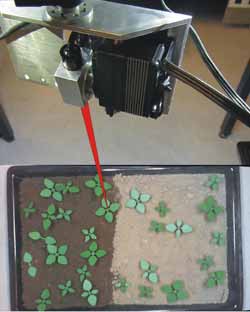Weed Control without Chemicals

Exact positioning of the laser beam (shown here in red) on weed model plants in a laboratory setting<br>
The laser beam can be used to selectively fight weeds in an early growth stage. This is the result of a current research project between the Laser Zentrum Hannover (LZH) and the Biosystems and Horticultural Engineering (BGT) faculty of the Leibniz Universität Hannover.
More and more, environmentally safe methods are being used to rid fields used for agricultural and horticultural of unwanted plants, or weeds. Chemical pesticides can be used selectively and are suitable for use where conventional, thermal methods such as flaming are either not exact enough, or are too energy consuming. However, drift and overdosing often lead to harmful herbicide residues in the top soil layers, or in surface water. By using an exact, selective laser beam, the growth of weeds can be impaired by destroying the sensitive growth centers of the plants, their so-called meristems. Current laboratory results show that a minimum dose of around 35 Joules is necessary to kill seedlings, and this laser energy can be exactly and effectively adapted to the plant species and growth stage.
Researchers from the LZH Department of Materials and Processes, Safety Technology Group are using a CO2 laser in the infrared range with a wavelength of 10.6 µm in their current investigations. The laser radiation has a direct thermal effect on the plants. By using a galvanometer scanner with a flexible mirror system, the laser beam can be moved quickly from plant to plant, and can be focused with high precision on the near-surface meristems. Under laboratory conditions, an accuracy of
A stereo camera system is used to recognize the plants and optimize the position of the laser beam. After using a complex processing method, scientists of the BGT have compared camera images based on threshold level filtering and edge detection, with Active Shape Models of the plants. The position of the leaves can be used to determine exactly where the meristem position is, and once these coordinates are found, a signal is sent to the laser to “hit the target”.
Scientists at the LZH have been able to determine exactly how much energy is needed to achieve an optimal effect on the target, making this method especially efficient. At the moment, different irradiation times in different weed concentrations are being tested concerning economic viability. Current knowledge shows that the best results for large areas can be provided by using autonomous field robots working in a stop-and-go mode.
The project „Investigations on the Effect of the Laser Beam on young Plants for Weed Control using Image Processing“ is subsidized by the German Research Foundation (DFG).
Contact:
Laser Zentrum Hannover e.V.
Michael Botts
Hollerithallee 8
D-30419 Hannover, Germany
Tel.: +49 511 2788-151
Fax: +49 511 2788-100
E-Mail: m.botts@lzh.de
The Laser Zentrum Hannover e.V. (LZH) carries out research and development in the field of laser technology and is supported by the Ministry of Economic Affairs, Labour and Transport of the State of Lower Saxony (Niedersächsisches Ministerium für Wirtschaft, Arbeit und Verkehr).
Media Contact
More Information:
http://www.lzh.deAll latest news from the category: Life Sciences and Chemistry
Articles and reports from the Life Sciences and chemistry area deal with applied and basic research into modern biology, chemistry and human medicine.
Valuable information can be found on a range of life sciences fields including bacteriology, biochemistry, bionics, bioinformatics, biophysics, biotechnology, genetics, geobotany, human biology, marine biology, microbiology, molecular biology, cellular biology, zoology, bioinorganic chemistry, microchemistry and environmental chemistry.
Newest articles

Properties of new materials for microchips
… can now be measured well. Reseachers of Delft University of Technology demonstrated measuring performance properties of ultrathin silicon membranes. Making ever smaller and more powerful chips requires new ultrathin…

Floating solar’s potential
… to support sustainable development by addressing climate, water, and energy goals holistically. A new study published this week in Nature Energy raises the potential for floating solar photovoltaics (FPV)…

Skyrmions move at record speeds
… a step towards the computing of the future. An international research team led by scientists from the CNRS1 has discovered that the magnetic nanobubbles2 known as skyrmions can be…





















